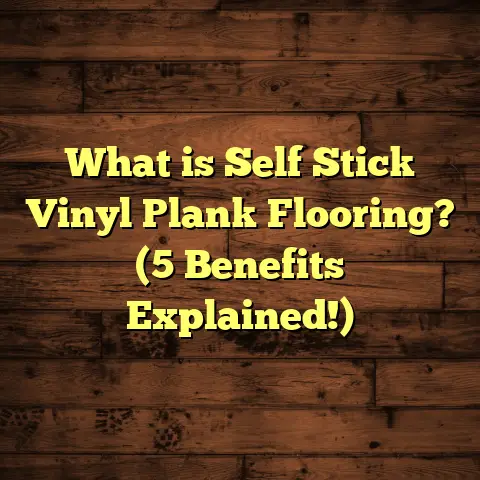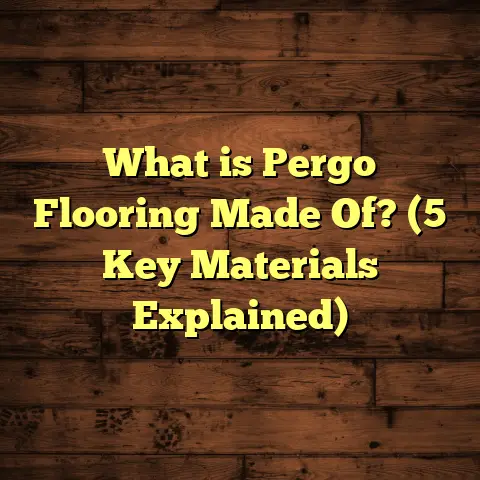What is Cheap Durable Flooring for Kitchen? (5 Best Options Revealed)
Sometimes, the idea of finding cheap durable flooring for a kitchen feels like chasing a unicorn—something that’s supposed to exist but is almost too good to be true. How do you get flooring that won’t break your budget but will still stand up to all the spills, foot traffic, and occasional kitchen dance parties? I’ve been through this myself, helping clients pick floors that last without costing a fortune. Here’s what I’ve learned along the way.
What Is Cheap Durable Flooring for Kitchen?
When I say cheap durable flooring for a kitchen, I mean flooring options that won’t drain your wallet but still handle the kitchen’s tough conditions. Kitchens see a lot of action — dropped knives, spilled sauces, heavy appliances, and constant foot traffic — so durability is non-negotiable. At the same time, many people want to keep costs down because kitchen renovations can quickly get expensive.
Durability here means the floor can resist scratches, dents, stains, and moisture damage for years. Cheap doesn’t necessarily mean low quality; it means you get the best value for your money. The goal is flooring that looks good and performs well without forcing you to replace it any time soon.
I’ve worked on many kitchen renovations where homeowners wanted flooring they wouldn’t regret six months later. Sometimes they didn’t want to spend thousands on hardwood or stone but still needed something that could take abuse from kids, pets, and busy cooking sessions. So, I focused on materials that offer a balance of price and long-lasting performance.
Why Kitchen Flooring Is So Different
Unlike other rooms, kitchens are a battleground for moisture, heat, dropped objects, and heavy foot traffic. This means your choice of flooring has to meet several criteria:
- Water Resistance: Spills happen all day long.
- Scratch Resistance: Kids’ toys, pets’ claws, and dropped utensils can leave marks.
- Ease of Cleaning: You want a floor that handles grease stains and crumbs without hours of scrubbing.
- Comfort: Since you might stand for long periods cooking, some cushioning is helpful.
- Longevity: The floor should last for years without showing wear.
Balancing these needs while keeping costs manageable is what makes cheap durable flooring a bit tricky—but not impossible.
1. Luxury Vinyl Plank (LVP)
If I were to recommend just one option for most kitchens looking to balance price and durability, it would be luxury vinyl plank (LVP). I’ve installed LVP dozens of times in my client’s homes and my own kitchen.
Why LVP Stands Out
LVP offers an impressive combination of affordability and resilience. It mimics the look of hardwood or natural stone remarkably well but without the vulnerability to water damage or scratches that real wood or stone might have.
- Waterproof Options: Many LVP products today are fully waterproof. I’ve seen it survive everything from spilled wine to a leaking dishwasher without warping or staining.
- Scratch and Dent Resistance: The wear layer protects against scratches from pets’ claws or dropped pots.
- Easy Installation: Floating floors with click-lock designs make LVP a favorite among DIYers. When I installed it myself in my kitchen, it took me just two weekends to finish a 300 sq ft area.
- Low Maintenance: Sweeping and damp mopping are usually enough.
Cost Breakdown
On average, LVP costs between $2 to $5 per square foot for materials. Installation varies between $1.50 to $3 per square foot if you hire a pro. For a 200 sq ft kitchen, expect total costs around $700–$1600 depending on quality and labor.
Real-Life Example
One client of mine had three kids and two dogs. They wanted something waterproof because their dog sometimes had accidents near the door. We picked a mid-grade LVP with a thick wear layer and waterproof core. Three years later, their floors still look flawless despite heavy daily use and multiple spills.
Installation Tips I’ve Learned
- Prepare the Subfloor: Make sure it’s clean, dry, and level before laying LVP.
- Acclimate the Planks: Leave them in the room for 48 hours before installation to avoid expansion issues.
- Use Underlayment: It adds cushioning and soundproofing.
- Leave Expansion Gaps: Floors need room to expand with temperature changes.
2. Porcelain Tile
Porcelain tile is often overlooked because of its higher upfront cost but it can be surprisingly affordable when you shop smart. It’s one of the toughest flooring materials you can get.
What Makes Porcelain Tile Worth Considering?
Porcelain tile is denser and less porous than ceramic tile. That means it resists moisture better — perfect for kitchens where water spills are frequent.
- Hardness: It resists scratches better than many other surfaces.
- Stain Resistance: Glazed porcelain prevents stains from setting in.
- Longevity: Properly installed porcelain can last decades.
- Variety: Comes in countless colors and styles from rustic stone looks to sleek modern tiles.
Costs & Installation
Basic porcelain tiles might start around $3 per square foot, but designer or large-format tiles can run $6-$10 per sq ft or more. Installation costs are generally higher due to the labor-intensive process—expect $5-$10 per sq ft including grout and sealing.
My Observations
In a kitchen remodel for a client who loved Mediterranean style, we used hand-painted porcelain tiles as accents combined with large neutral tiles for durability. The overall project was slightly above budget but the floors still look stunning after 5 years with no damage.
Pro Tips From My Experience
- Use a high-quality grout sealer to prevent staining.
- Consider textured tiles for slip resistance.
- Pre-plan layout carefully — tile cutting errors can waste material.
- Porcelain can feel cold underfoot; adding radiant heat underneath makes it cozy.
Data Insight
Porcelain tiles generally have a water absorption rate under 0.5%, significantly lower than ceramic tiles (up to 3%). This makes them almost impervious to water damage.
3. Laminate Flooring
Laminate has earned a mixed reputation because early versions weren’t water resistant. But newer laminates with improved cores are making kitchens viable again.
Why Laminate Might Be Right for You
Laminate offers realistic wood looks at much lower costs than hardwood. The latest water-resistant laminates can handle kitchen moisture better than before.
- Scratch Resistant Surface Layers: Great if you have pets or kids.
- Affordable: Usually between $1 to $4 per square foot.
- Variety of Styles: From light oak to dark walnut finishes.
- DIY Friendly: Click-lock installation saves labor costs.
My Personal Story With Laminate
I once recommended laminate to a young couple on a tight budget who wanted wood-look floors but couldn’t afford hardwood or LVP at the time. We chose a water-resistant laminate with a decent wear layer. It’s held up well for over 4 years even with spills and pet traffic.
Things To Watch Out For
- Avoid low-end laminates with paper-based cores that swell when wet.
- Use moisture barriers underneath if installing over concrete basements.
- Clean spills immediately since water left standing can cause damage.
- Consider underlayment for soundproofing and cushioning.
Cost Comparison
Laminate installation is cheaper than tile or hardwood—typically $2-$5 per square foot including labor—which makes it popular for budget kitchens.
Research Findings
Tests show high-quality laminate scratch resistance scores close to oak hardwood on the Janka hardness scale (a measure of wood hardness). Some brands also offer anti-microbial coatings which help prevent mold in damp environments.
4. Sheet Vinyl Flooring
Sheet vinyl often gets dismissed as outdated but modern versions offer durability and style at an unbeatable price point.
Why Choose Sheet Vinyl?
Sheet vinyl sheets provide continuous coverage with no seams in smaller kitchens, reducing places for dirt and water to collect.
- Waterproof: Perfect for kitchens prone to spills or leaks.
- Comfortable Underfoot: Softer compared to tile or hardwood.
- Inexpensive: Material costs often below $2 per sq ft.
- Easy Maintenance: Wipes clean easily with mild detergents.
My Experiences Installing Sheet Vinyl
For landlords managing rental properties, sheet vinyl is my preferred option because it balances cost-effectiveness with resilience. I’ve seen vinyl floors last over 10 years in rentals with minimal upkeep required.
Installation Notes
- Subfloor must be smooth and clean since imperfections show through thin vinyl.
- Use adhesive designed for vinyl to avoid bubbling.
- Roll out slowly to avoid wrinkles.
- Professional installation recommended for large areas.
Cost Insights
Total cost including installation usually runs between $3-$5 per square foot—often less expensive compared to tile or LVP projects.
Data Snapshot
According to flooring industry data, sheet vinyl floors have an average lifespan of 10–20 years when maintained properly.
5. Cork Flooring
Cork is less common but offers unique benefits that make it worth considering if comfort and durability matter.
Why Cork Is A Hidden Gem For Kitchens
Cork’s natural resilience means it bounces back from impacts better than many hard surfaces. It’s also naturally antimicrobial which helps keep kitchens hygienic.
- Comfort: Soft yet supportive underfoot—great if you stand long while cooking.
- Water Resistance: When sealed properly, cork handles kitchen moisture well.
- Thermal Insulation: Keeps floors warmer in colder climates.
- Eco-Friendly: Made from renewable bark harvested without cutting trees.
My Cork Flooring Story
A client who loved cooking but had foot pain chose cork flooring in their kitchen after I explained its benefits. They reported less fatigue after hours standing at the stove. The cork floor is sealed every few years which keeps it water-resistant and looking great after 6 years.
Pricing & Care
Cork costs about $3-$6 per square foot depending on quality and thickness. You need to reseal every few years to maintain water resistance.
Things To Keep In Mind
- Avoid heavy furniture without protective pads—it can dent cork surface.
- Use mild cleaners; harsh chemicals damage sealants.
- Avoid standing water spills; wipe up quickly.
Comparing These Options Side-by-Side
| Flooring Type | Cost (Material + Installation) | Water Resistance | Durability | Maintenance | Comfort Level | DIY Friendly? |
|---|---|---|---|---|---|---|
| Luxury Vinyl Plank | $3 – $8 per sq ft | Waterproof (many types) | High | Low (simple cleaning) | Medium | Yes |
| Porcelain Tile | $8 – $15+ per sq ft | Very High | Very High | Medium (grout sealing) | Low (cold/hard) | No |
| Laminate | $2 – $6 per sq ft | Water-resistant types | Medium | Medium (quick spill cleanup) | Medium | Yes |
| Sheet Vinyl | $3 – $5 per sq ft | Waterproof | Medium | Low (wipe clean) | High | Possible |
| Cork | $5 – $8 per sq ft | Water-resistant w/seal | Medium | Medium (resealing needed) | High | Yes |
Practical Tips For Choosing Your Kitchen Floor
I always tell clients to think about:
- Your Kitchen Use: Do you cook often? Have kids or pets? Expect lots of spills?
- Budget Range: Total cost includes materials + installation + maintenance over years.
- Style Preferences: Do you want wood looks? Stone? Something colorful or neutral?
- Installation Willingness: Are you hiring pros or DIYing?
- Longevity Expectations: Some floors last longer but cost more upfront.
Maintenance Hacks That Save Money Long-Term
The best floor can look awful fast if not cared for properly. Here’s what I recommend:
- Clean spills ASAP—especially on laminate and cork.
- Use rugs or mats near sinks to catch drips.
- Avoid abrasive cleaners; stick with pH-neutral solutions.
- Protect floors from heavy furniture with pads or coasters.
- Re-seal porous floors like cork every few years.
- Vacuum or sweep regularly to prevent dirt scratches.
Real Case Study: Budget Kitchen Flooring Success Story
Last year, I worked with a young family renovating their first home kitchen on a tight budget ($3k max). They wanted durability because they have toddlers and pets but couldn’t go hardwood or stone due to cost.
We chose mid-range luxury vinyl plank with waterproof core and scratch-resistant wear layer. Installation was done professionally over two days for about $1500 total including materials.
Now after 18 months, they report zero issues: no scratches, no water damage despite kids spilling drinks daily, easy cleaning routine with sweeping & mopping only.
They told me they saved thousands compared to hardwood or tile but got similar durability and style benefits. That made me proud because this flooring gave them peace of mind without breaking their bank.
Final Thoughts From Me
Finding cheap durable flooring for your kitchen doesn’t have to be stressful or expensive. I’ve seen so many homeowners surprised by how good budget-friendly materials can perform when chosen wisely. You just need to balance what fits your lifestyle and budget while thinking ahead about wear and tear.
If you want something waterproof and low-maintenance, luxury vinyl plank is hard to beat. For timeless durability, porcelain tile remains a strong contender even on a budget if you shop smart. Laminate and sheet vinyl offer great cost savings with decent durability if you pick quality products. And cork offers comfort plus durability if maintained well.
Whichever option you lean toward, focus on quality materials combined with proper installation—this combo is what keeps kitchens looking great without constant repairs or replacements years down the line.
Got questions about your specific project? I’m here to help you sort through choices so you get floors you love—and that last long!





